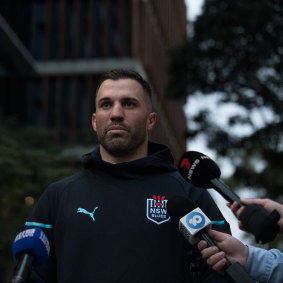Kicking goals through preparation and practice
Mia Drummond Young was always a committed student who took her studies seriously. But the Loreto Kirribilli graduate even surprised herself when her preparation and effective study techniques led to her topping the PDHPE course in last year’s HSC.
“I had great teachers, who made it very easy to make me want to work hard. Achieving satisfying results was important to me but equally as important was picking subjects that I loved,” Drummond Young said.

Mia Drummond Young topped visual arts and PDHPE in the HSC.Credit: James Brickwood
Teacher feedback, reviewing past papers and knowing the key terms from the syllabus were central to her HSC success in PDHPE (Personal Development, Health and Physical Education).
“Practice makes perfect, especially in subjects like PDHPE which cover so much ground,” Drummond Young said. “Regularly attempting past papers helped me grasp all things PDHPE and prepare effectively for exams.”
Applying herself with sound study techniques brought success for Drummond Young in other areas of her life, too; she was offered opportunities to study dance full-time and achieved equal first in Visual Arts.
“While it was sad, choosing not to continue dance was the right decision for me. Now, I can channel my energy into teaching dance and my studies,” said Drummond Young, who has chosen to study Veterinary Science at the University of Sydney.
“Thanks to the high marks I achieved, I secured a position in Science upon graduating, which gave me the time to see which field I wanted to move into. I’ve moved into Veterinary Science - I’m loving it and have been able to apply a lot of the knowledge and concepts I learnt in PDHPE.”
Drummond Young’s tips for HSC PDHPE
- Get to know the subject specific glossary of terms: “Knowing the key words outlined in the syllabus is crucial; understanding what the examiners are looking for enables you to tailor your responses accordingly and demonstrate your knowledge effectively.” NESA’s glossary of key words helps students prepare for the HSC. They are available on NESA’s website within each course’s syllabus document.
- Take feedback seriously and do practice papers: “Use the feedback from your trials and other exams as a roadmap for improvement, redefining your understanding and application of the syllabus.”
- Connect theory to real life: “Understanding how PDHPE concepts apply to real-life scenarios enhances learning and makes the content more relatable.”
Football star looks to the future
Growing up on 250 acres in Sydney’s outskirts, kicking a football around has always been part of James Tedesco’s life.
He was recruited into a rugby league development program, then selected to play in the Australian Schoolboys team while at the well-known training ground for up-and-coming talent, St Gregory’s College Campbelltown.
“PE was the subject I was most interested in. I loved sport and I loved playing all types of sports and obviously PE has that in the curriculum,” said the captain of the Roosters’ and the Australian Kangaroos rugby league team.

Rooster James Tedesco looks to pass the ball. He studied teaching at the Australian Catholic University as his professional football career unfolded.Credit: Getty
Although his sights were set on professional football, Tedesco prepared for a possible future teaching Personal Development Health and Physical Education (PDHPE) and completed a degree at the Australian Catholic University.
“After year 11 and 12, a lot of my friends wanted to be PE teachers and that was driving me to try and put a lot of time and effort into [study],” said Tedesco.
That time and effort paid off: Tedesco achieved an ATAR rank of 81.

Facing the media pack: Tedesco graduated with an ATAR of 81 in 2010 and his name is on the HSC honour roll after getting a top performance band in PDHPE.Credit: Flavio Brancaleone.
Despite finding it difficult to concentrate sometimes, Tedesco said he recommends committing to a study routine. Regular sessions – even if they’re brief – are sure to improve results.
Tedesco is on the 2010 honour roll for achieving results in the HSC top performance band for PDHPE.
Tedesco’s top tips for HSC PDHPE
- Dedicate time and space for study: “At St Greg’s, there were a lot of boarders and they have their allocated time for study. At home, I had my desk and… I couldn’t concentrate for hours on end, but just took time to study my notes.”
- Don’t rule out a Plan B: “It was always my dream to play in the NRL, but I knew it wasn’t guaranteed so I had to put some time and effort into my study as well.”

PDHPE studies provides students with a good understanding of health and the importance of physical activity.Credit: Janie Barrett
HSC marker advice: PDHPE
Craig Baker, PDHPE teacher, St Luke’s Grammar School
I enjoy teaching PDHPE because it empowers students with applicable knowledge and skills that extend far beyond the classroom. It provides students with a holistic understanding of health and equips them to have a positive influence, on not just their own health but also their families, community and broader societal health outcomes.

Craig Baker is a PDHPE teacher at St Luke’s Grammar School.
A HSC marker’s top dos and don’ts
- Be explicit in your examples with sufficient depth to not only support your response but also address the question’s requirements. Marking guidelines require “relevant examples” in the top mark ranges, relevant to both the content and depth of response. Examples should be evident for every syllabus area covered in your response.
- Spend time completing several practice questions. The PDHPE HSC examination can require the application of the syllabus content in any number of ways. Attempt multiple questions that require you to apply the same syllabus areas in different contexts.
- Ensure your response is structured and sequential in how it attempts to answer the question. Marking guidelines for the extended questions can require responses to be “logical and cohesive” to attain the higher marks.
- Don’t neglect NESA’s glossary of key words. Understanding what the question wants you to do with the syllabus content will help you provide a response that answers the question.
- Don’t be colloquial in your responses. Correctly used key course terminology will help demonstrate your high level of understanding of the content.
- Don’t just brain-dump all the information you know about a particular concept. Your response needs to be relevant and answer the question.
Read our other HSC Study Guide 2024 stories
Check out Campus, our higher education hub, including an interactive course search tool